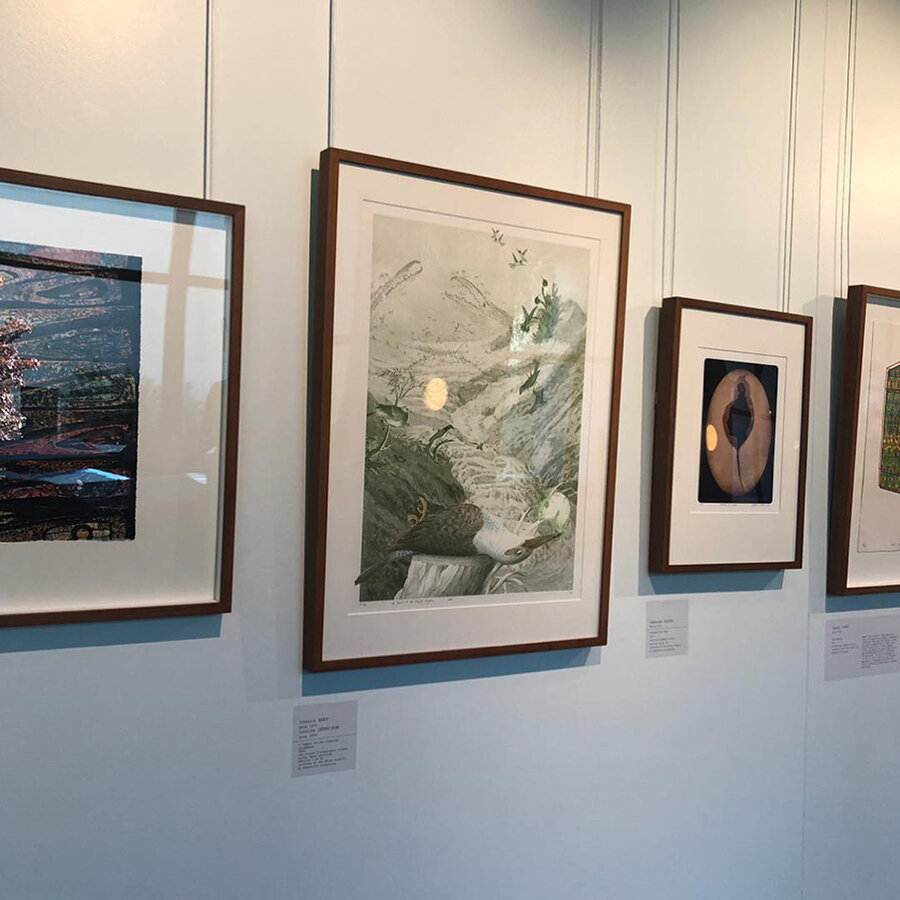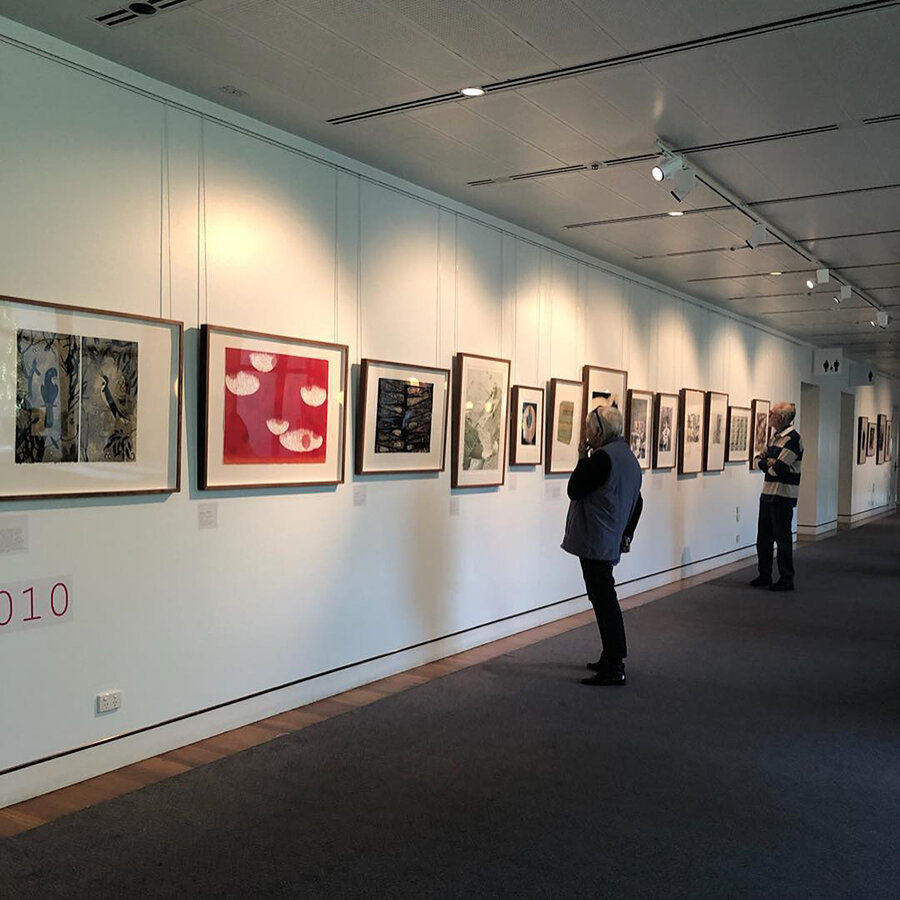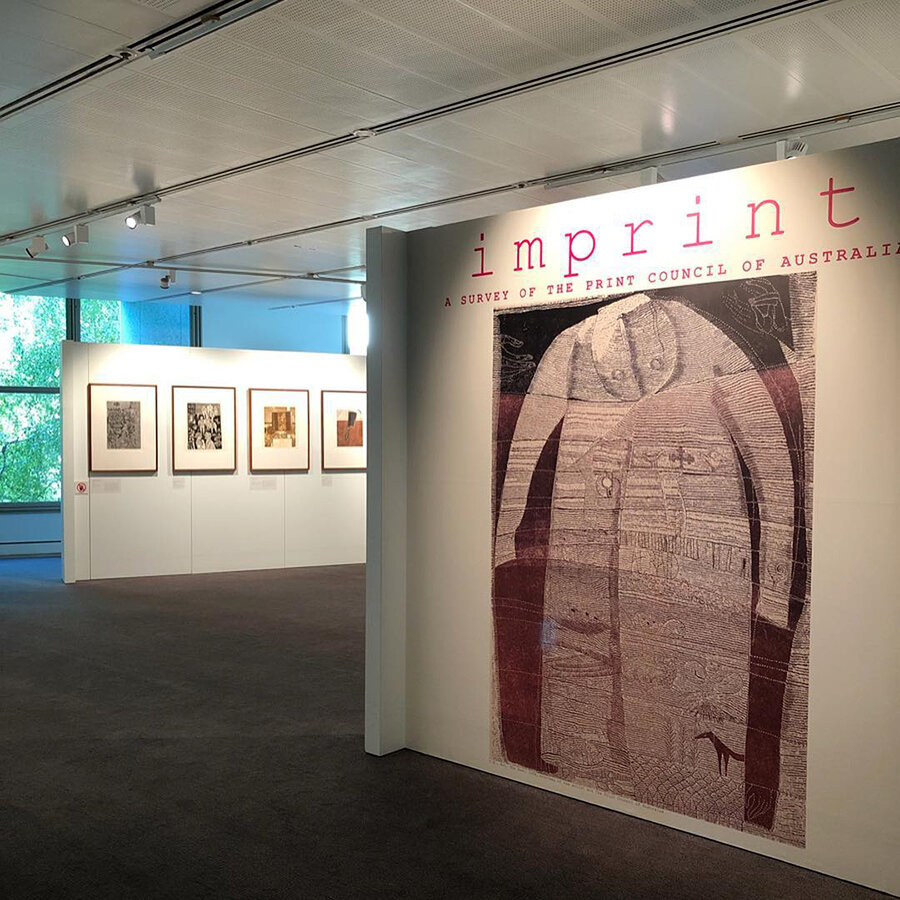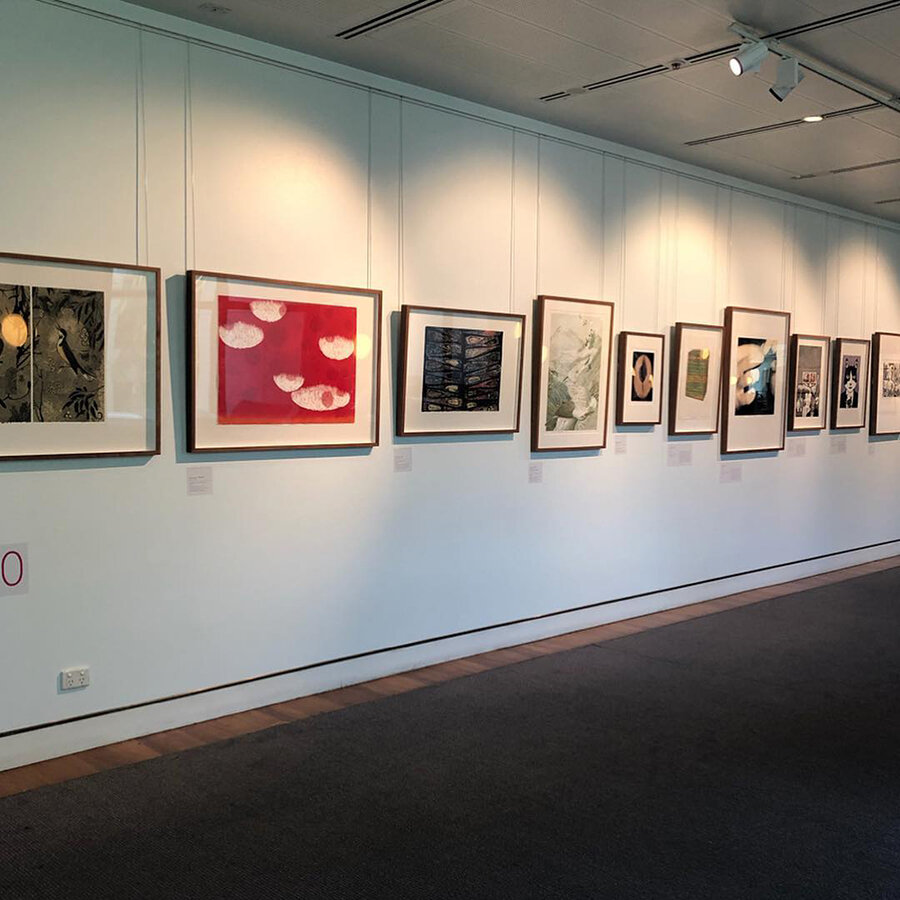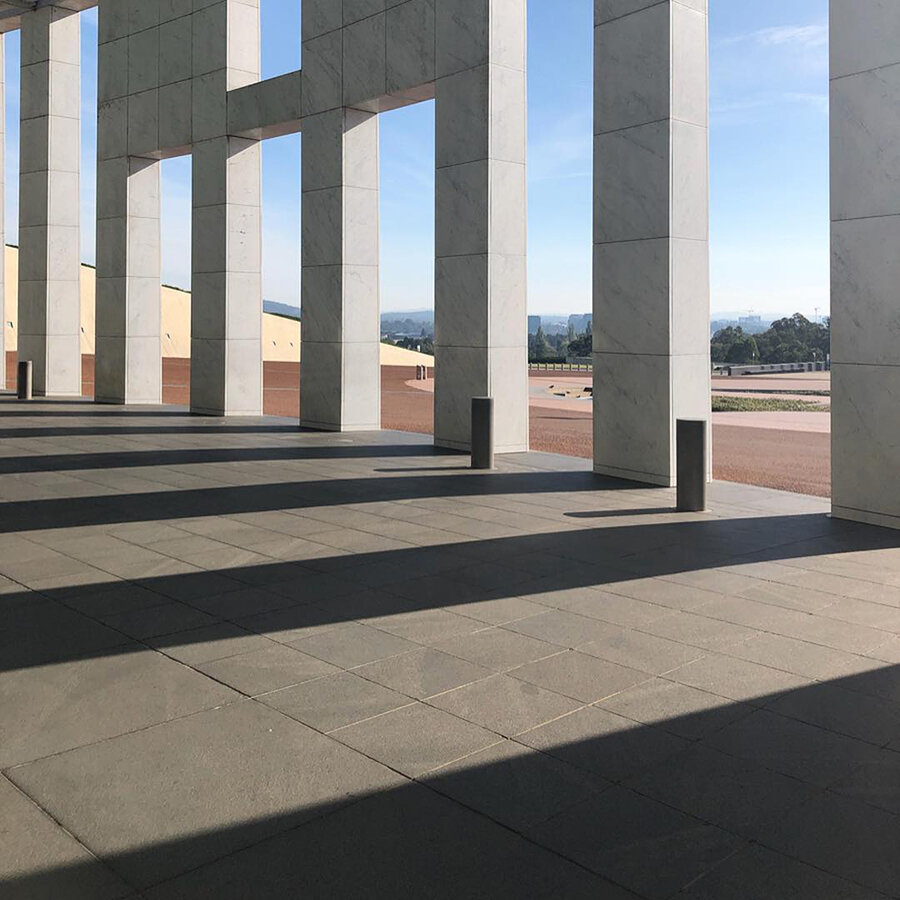THREE PRINTS, 2003–2004
1/ Gracia Haby & Louise Jennison
The plight of the birds
2003
Two-color lithographic offset print hand colored with pencil and pearl ex pigment additions on blue Magnani PESCIA 2021/P 300gsm paper
Paper size, 56cm X 76cm
Printed by Redwood Prints
Edition of 25
Gracia Haby & Louise Jennison
The tears of the elephant
2003
Two-color lithographic offset print hand colored with pencil and pearl ex pigment additions on buff Magnani PESCIA 2021/G 300gsm paper
Paper size, 56cm X 76cm
Printed by Redwood Prints
Edition of 25
In the print The plight of the birds you can see an upside-down King bird of paradise (Cicinnurus regius), and what is believed to be a Whimbrel (Numenius phaeopus), from Omstandig Verhaal van de Geschiedenissen in Ambrosia by François Valentinjin, 1724–6, which features A. R. Wallace’s description of a King bird of paradise.
”It was a small bird, a little less than a thrush. The greater part of its plumage was of an intense cinnabar red, with a gloss as of spun glass. On the head the feathers became short and velvety and shaded into rich orange, Beneath, from the breast downwards, was pure white, with the softness and gloss of silk, and across the breast a band of deep metallic green separated this colour from the red of the throat…. Merely in arrangement of colours and texture of plumage this little bird was a gem of the first water.”
There is also a pair of Blue tits (Pasus caeruleus), from an engraving by J. D. Meyer (1748–56), and a Yellow-throated warbler (Dendroica dominica), from plate 62 of The Natural History of Carolina by Marc Catesby (1731–43).
In the print The tears of the elephant , amongst other things, you can see a Black guillemot or Tystie (Cepphus grylle) from a lithograph by Mrs Hugh Blackburn, plate VI in Birds drawn from nature, 1868, who describes her methods in the introduction:
”In order to carry out the same idea of interposing as few interpreters as possible between nature and the actual print, the drawings have been copied onto the stone (or zinc plate) by the same hand as made the original drawings, or in some instances the drawing has been made on the stone direct from nature.”
●
RAYMOND ARNOLD, JON CAMPBELL, GUNTER CHRISTMAN, JAZMINA CININAS, LESLEY DUXBURY, GRACIA HABY & LOUISE JENNISON, MITCH LANG, NOEL MCKENNA, DEBORAH PAAUWE, GEORGE POPPERWELL, BERNHARD SACHS, HOSSEIN VALAMANESH
ACT XII: NEW WORKS ON PAPER
2003
GEORGE ADAMS GALLERY, ARTS CENTRE MELBOURNE, MELBOURNE
UTS GALLERY, UNIVERSITY OF TECHNOLOGY, SYDNEY
ARTSPACE, ADELAIDE FESTIVAL CENTRE, ADELAIDE
Recent work by twelve Australian artists who have a particular affinity with paper. These invited artists each explore ideas of performance, the stage and enactment through printmaking, drawing, painting, collage, artist’s books, sculpture and digital images.
Twelve acts in time: staging art on paper
Lesley Harding, Curator
2003
Since its birth over 2000 years ago, paper has been both currency and disseminator of culture and ideas. Its relevance has long since reached global proportions. Who of us in the Western world, despite the advances of technology and aspirations for a ‘paperless office’, does not encounter paper everyday? Paper transmits information, conveys ideas, and is the most democratic of supports. But above all, paper has a memory. It bears human marks and meanings almost sacrificially.
The works in Act XII are linked by two things: they are made on or with paper, and they coalesce in a performative thematic context, which broadly considers notions of staging in art and the artistic enactment of ideas. The act of making art — the creating process — is intrinsic to the finished product. So, in addition to the message, story, symbolism, subject or motif, and the artist's own predilections and history, an artwork is as bound by the act of its creation as it can be by the period and milieu of its creation. The gestural act is a moment which sums up an accumulation of moments (as a part of history and its place in the artist’s life) and is a function of time.
....
Using diaries of a different kind, Gracia Haby and Louise Jennison have made an art of their everyday. In Melbourne in 31 days and 30 days in Vienna, the most recent of eight collaborative artists’ books, they couple detailed diarised text — more stream of consciousness than interpretation — that chronicles the pair’s activities over a predetermined period, with the collected haberdash of life. Together with scanned images, hand-drawn pictures, notation and intricate embellishment, the books make for insightful and delightful reading. Part of a journey, the book made in Melbourne became a performance piece at the Weinstation in Vienna in March 2002. The performance was a turning point, metaphorically blurring the experience of the months. The experience of the Vienna trip was compiled for another book on the artists' return; the gestural act in real time.
The openness and delicacy of these works can also be seen in Haby and Jennison’s pale, luminous prints of fantasy lands. Their The plight of the birds and The tears of the elephant are two optimistic tales, depicting a search for happiness in which narrative time is mapped by the fine longitudinal lines that pattern the print surface. In recounting real stories and creating imagined tales, Haby and Jennison engage the motions of staging — shifts in time, scale and space — to make art out of art’s own enactment.
ACT XII: New Works on Paper catalogue essay
Marita Smith
Gracia Haby and Louise Jennison have worked collaboratively for the past five years, using paper as their primary medium. From a series of carefully constructed, limited edition artists’ books through to works on and with paper, their intimate art pieces record, deconstruct and respond to experiences in various countries and varying circumstances.
Their two most recent artists’ books depict their shared love of travel, both real and imagined. Their work Melbourne in 31 days presents a tale told in unnumbered pages. Housed in a delicately constructed straw board box, it comprises two volumes. the first, a manuscript by Jennison in a continuous stream, chronicles the activities of one month. It opens with waking on the first day and concludes with going to bed one month later. The second volume, an assemblage of ephemera acquired in the same month — a ticket stub, a letter extract, a receipt, a menu card — are mementos held onto, small visual clues of days past serving as memory cues.
30 days in Vienna, bound by the artists with an exposed spine and square knot binding technique learnt in Switzerland, combines interpretive text by Haby with images, both of which are woven through collaged layers.
These exquisite volumes command quiet contemplation. Their primary concern is the paradox of preserving the ephemeral. They capture ordinary moments, elevating the significance of everyday experience.
While the books attempt to preserve time, two lithographic offset prints, The plight of the birds and The tears of the elephant, have no tangible reference points. They create whimsical landscapes with ambiguous narratives open to many levels of interpretation. Drawing from a history of imaginary voyages, these works engage the senses and create a warm tension.
For Haby and Jennison, life and art nourish each other. Their travels provide inspiration and content, and threads of their art-making experience are woven into their stories. Though this may not be a conscious pursuit, the interdependence of art and life is an emerging theme in their recent body of work. The artists’ journey is compelling.
Haby and Jennison are Fine Arts graduates of RMIT (Haby with Honours) and have exhibited together locally and abroad. They were awarded the Australia Council for the Arts, New Work for Emerging Artists grant in 2000 and the Freedman Foundation Travelling Scholarship for Emerging Artists in 2002. They are represented in the collection of the State Library of Victoria and in private collections.
Gracia Haby & Louise Jennison
A lament to the sleeping kingfisher
2004
Two-color lithographic offset print hand-colored with pencil on BFK Rives white 250gsm
Image size 48cm X 68cm
Paper size 56cm X 76cm
Printed by Redwood Prints
Edition of 40 with bon à tirer and six artists’ proofs
A lament to the sleeping kingfisher was commissioned for the Print Council of Australia as one of their 2004 commissioned prints.
“The PCA Print Archive commenced in 1967 when the first Print Commission process, then titled the Member Print, was held. From 1967 until 1990 one print from each commissioned edition has been archived. Since 1990 two prints have been archived. The PCA Print Archive now numbers in excess of 500 works including all commissioned and Presidential prints. The only curatorial intent determining the collection being the fostering of contemporary prints and print practice.”
A lament to the sleeping kingfisher was later exhibited as part of Imprint: A Survey of the Print Council of Australia at Parliament House, Canberra, in 2019.
Imprint: A Survey of the Print Council of Australia
Friday 1st of March – Sunday 12th of May, 2019
Level 1, Parliament House, Canberra, ACT
This special exhibition featuring prints from the Print Council of Australia’s archival collection includes some of the first prints created by significant Australian artists, including the first Print Commissions, John Brack’s Untitled (Skaters), 1967, and Fred Williams’ Lysterfield, 1968, and the first Indigenous Australian Print Commission, Bush Figures by Ku Ku Imidji man Arone Raymond Meeks, along with works produced by PCA founders Grahame King and Udo Sellbach.
The Commission, which began in 1967, invites artists to submit a limited-edition print for consideration by the PCA and its members. This has resulted in an archive of more than 600 prints, illustrating the rich history of contemporary Australian printmaking.
Works of master printers and innovators including Noel Counihan, Barbara Hanrahan, David Rose, Ray Beattie, Bea Maddock, Earle Backen, Ruth Faerber, Hertha Kluge-Pott, Olga Sankey, Judy Watson, Janet Dawson, Mary MacQueen, Raymond Arnold, G.W. Bot, Yvonne Boag, James Taylor, John Coburn, Jenuarrie Warrie, Maria Kozic, Wilma Tabacco, Rick Amor, Treahna Hamm, Robert Jacks, Bruno Leti, John Olsen, Michael Kempson, Susan Pickering, Andrew Ngungarrayi Martin, Belinda Fox, Georgia Thorpe, Gracia Haby & Louise Jennison, Gosia Wlodarczak, Rebecca Mayo, Janet Parker-Smith, Rona Green, Sophia Szilagyi, Glen Mackie, Tama Favell, Elizabeth Banfield, David Fairbairn, Graeme Drendel, Deanna Hitti, Sue Poggioli, Maria Orsto, Samuel Tupou, Pia Larsen, Deborah Klein, Cat Poliski, Heather Koowootha and Glenda Orr will also be on show, as will a diverse range of printing techniques representing styles from the late 1960s: from relief printing (carving into lino or wood where recessed areas don’t hold ink and transfer to paper ink-free) to intaglio (etching, engraving, aquatint, drypoint, mezzotint) and planographic (lithography and screen-printing) as well as digital printing.
While the exhibition is mostly Print Council of Australia works — fifty-eight works — the remainder are from the Australian Parliament House Art Collection, including two new acquisitions, linocuts by artist Jenny Kitchener, recipient of the 2017 Print Council Commission.
The Print Council of Australia was established in Melbourne in 1966 by printmakers Udo Sellbach, Grahame King and curator Dr Ursula Hoff to promote the artform of printmaking. The 1940s–60s had seen the return to Australia of European-trained artists, sparking a resurgence in the importance of printmaking and its commercial viability.
Imprint: A Survey of the Print Council of Australia is showing in the exhibition area, level 1, Parliament House, Canberra, from 1 March–12 May, 9am to 5pm daily. Free.
Special Event: The Mini-Print and Zine Fair, Saturday 13 April, 10am to 2pm, exhibition area, level 1.
Print Council of Australia


